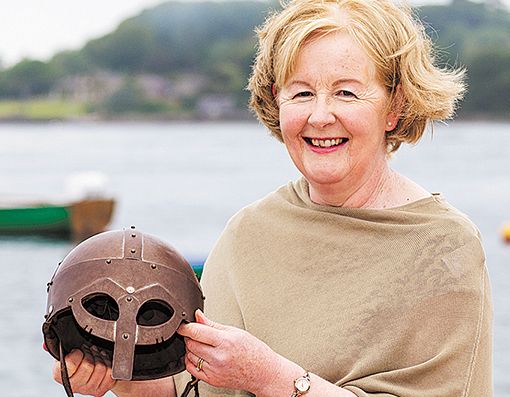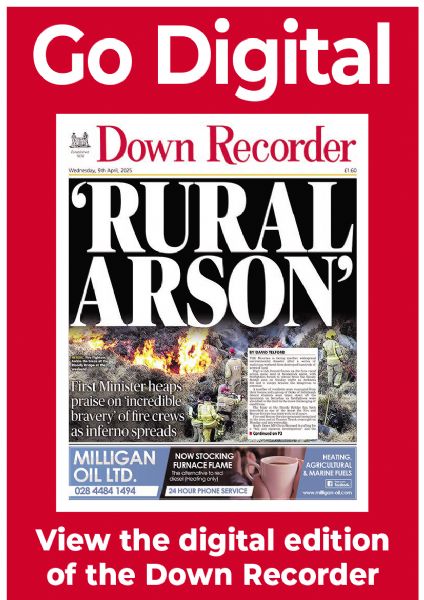The Vikings on and around the shores of Strangford Lough
The Vikings on and around the shores of Strangford Lough
14 July 2021

THE Vikings set out on voyages from Scandanavia to many countries in Europe and beyond and were explorers, raiders, traders, colonisers.
They first came to Ireland at the end of the eighth century and returned during the following centuries up to the early 12th century with their main interest to gain land and slaves.
There are many reasons given for the early Viking raids on Britain and Ireland but the most likely reason was that young men who were not likely to inherit land set off on voyages of discovery to other countries for material gain.
The Vikings were skilled craftspeople and were particularly skilled at building the famous longships equipped with sails and oars which were ideally suited for mounting raids on coastal monasteries and travel by river.
The first raid on Ireland happened in 795 AD when the Vikings beached on Lambay island off Dublin. Known as ‘Danes’ they actually came mainly from Norway.
These helmeted warriors armed with swords, spears and axes ransacked monastic villages for valuables such as silver and gold chalices, ornaments, cattle and slaves. Monasteries were centres of wealth and they were an easy target for the raiders to reach as they were located at or near coastal sites.
For example, Nendrum monastic site in Strangford Lough was raided as was the monastery in Downpatrick which at that time was coastal. The monastic site at Bangor was attacked in 823 and 824 AD.
Indeed, the fear of Viking attacks is recorded in the lines of a poem written in a manu in 820 AD by an Irish monk:
Fierce and wild is the wind tonight
It tosses the tresses of the sea to white
On such a night as this I take my ease
Fierce Northmen course only the quiet seas
A stormy night at sea meant the monks could sleep peacefully at night without fear of a Viking raid.
The original name of Strangford Lough was Loch Cuan which means the quiet lough.
When the Vikings came they renamed it Strang Fjord (Strangford) which means the ‘fjord of the strong currents’. The Narrows is renowned for its’ fierce currents, while a fjord is a long narrow inlet of the sea formed by glacial action.
There is evidence for the presence of the Vikings on Strangford Lough in the ninth and 10th centuries and the Vikings had a base in Strangford Lough for their fleets of longships engaged in struggles in the Irish Sea and elsewhere.
In the Annals of Ulster it states that Downpatrick was attacked and plundered by the Vikings once in the ninth century, twice in the 10th century and twice in the 11th century (raiders unnamed). Movilla was attacked in 825 AD and Kilclief monastic settlement in 935 and 1001.
The Battle of Strangford Lough was fought in 877 between two rival groups of Vikings and the Viking King of Dublin and York, Halfdan Ragnarsson was killed in the sea battle.
The Vikings were defeated at the Battle of Clontarf in 1014 by the great chieftain and hero Brian Boru. There was a murder of international significance when Magnus Barelegs (Olafsson), King of Norway was killed in 1103 near Downpatrick.
He was a Viking adventurer who had become King of Norway in 1098. In 1102 he set off for Ireland and in that year took control of Dublin. He was ambushed and killed by the Ulaid — the native Irish — while in the process of acquiring cattle provisions for his journey home.
He is buried near the town of Downpatrick and was the last Viking King to rule the Irish Sea, with his grave the only recorded grave of a Norwegian Viking king outside Scandanavia.
The Vikings were also very skilled in making beautiful jewellery.
A silver Viking bracelet was discovered in farmland in the townland of Inishargy near Kircubbin in County Down in 2012 and is believed to date back to the 10th or 11th century and is an example of an object made to a specific weight to be used as currency in trade. In 2018, a silver Viking ring believed to date to the ninth or 10th century was found near Groomsport. Viking rings are rare with only 15 in the whole of Ireland.
The legacy of the Vikings includes the establishment of key towns and cities in Ireland such as Waterford and Wexford. Their influence is also evident in our language and coinage.
The Vikings intermarried with locals and some Irish surnames are derived from Old Norse including McKitterick, MacManus McAuley and Cotter. The Vikings chose some memorable names for their warriors such as Thorfinn the Skull Splitter and Eric Bloodaxe.
The first coin to be minted in Ireland was produced for King Sitric, Viking King of Dublin until 1036 and some words in our language of Viking origin include bletherin – talking nonsense; ram-stam —headlong; smiddy —a forge; a whelp —a young dog and a ‘pladdy’ – a flat sunk rock.
Anyone who would like to learn more about the Vikings and have the opportunity to see and handle a range of Viking artefacts including a sword, an axe, a dagger, a long boat and a helmet first hand can book a place on the Viking experience organised by Ards and North Down Council.
It is scheduled to take place this Saturday at 2pm in Portaferry and for further info visit https://www.ticketsource.co.uk/ardsandnorthdown/t-endrra


